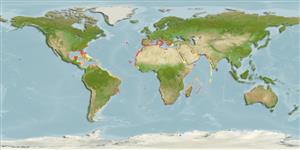>
Blenniiformes (Blennies) >
Blenniidae (Combtooth blennies) > Salariinae
Etymology: Parablennius: Greek, para = the side of + Greek, blennios = mucus (Ref. 45335).
More on author: Cuvier.
Environment: milieu / Klimaatzone / Diepte / distribution range
Ecologie
marien demersaal; diepte 0 - 25 m (Ref. 5298). Subtropical; 44°N - 56°S
Eastern Atlantic: Spain and Portugal to Möwe Bay, Namibia. Also in the Mediterranean along the coast from Morocco, Algeria, Spain. Southwest Atlantic: Brazil and Patagonia, Argentina (Ref. 4404). Western Indian Ocean: Natal to Knysna in South Africa.
Grootte / Gewicht / Leeftijd
Maturiteit: Lm ? range ? - ? cm
Max length : 12.7 cm SL mannelijk / geslacht onbekend; (Ref. 5298)
Dorsale stekels (totaal) : 11 - 12; Dorsale zachte stralen (totaal) : 18 - 24; Anale stekels: 2; Anale zachte stralen: 20 - 25. Body with up to 9 dusky bands above and dark spots below; sometimes pale with irregular dusky marks; 2 dark bands on underside of head; pectorals pale to dusky pale in color; dorsal fin dusky or with many spots (Ref. 4404).
Body shape (shape guide): fusiform / normal.
Facultative air-breathing in the genus (Ref. 126274); Adults occur in rocky shores, often at steep walls of surf-exposed sites (Ref. 5981). Oviparous. Eggs are demersal and adhesive (Ref. 205), and are attached to the substrate via a filamentous, adhesive pad or pedestal (Ref. 94114). Larvae are planktonic, often found in shallow, coastal waters (Ref. 94114).
Levenscyclus en paargedrag
Maturiteit | Voortplanting | Paaien | Eieren | Fecunditeit | Larven
Oviparous, distinct pairing (Ref. 205).
Springer, V.G., 1986. Blenniidae. p. 742-755. In M.M. Smith and P.C. Heemstra (eds.) Smiths' sea fishes. Springer-Verlag, Berlin. (Ref. 4404)
Status op de Rode Lijst van het IUCN (Ref. 130435: Version 2025-1)
Gevaar voor de mens
Harmless
Gebruik door de mens
Tools
Speciale rapporten
Download XML
Internetbronnen
Estimates based on models
Preferred temperature (Ref.
123201): 18 - 27.9, mean 26.4 °C (based on 1539 cells).
Fylogenetische diversiteitsindex (Ref.
82804): PD
50 = 0.5000 [Uniqueness, from 0.5 = low to 2.0 = high].
Bayesian length-weight: a=0.01096 (0.00465 - 0.02585), b=2.99 (2.81 - 3.17), in cm total length, based on LWR estimates for this Genus-body shape (Ref.
93245).
Trofisch niveau (Ref.
69278): 3.2 ±0.40 se; based on food items.
Weerstandsvermogen (Ref.
120179): Hoog, minimale populatieverdubbelingstijd minder dan 15 maanden (Preliminary K or Fecundity.).
Fishing Vulnerability (Ref.
59153): Low vulnerability (10 of 100).
🛈
Nutrients (Ref.
124155): Calcium = 185 [102, 374] mg/100g; Iron = 1.38 [0.88, 2.36] mg/100g; Protein = 18.8 [17.9, 19.6] %; Omega3 = 0.373 [0.230, 0.607] g/100g; Selenium = 15.1 [8.2, 30.1] μg/100g; VitaminA = 23.9 [8.3, 66.4] μg/100g; Zinc = 1.19 [0.85, 1.71] mg/100g (wet weight);
